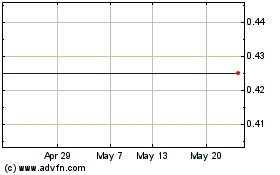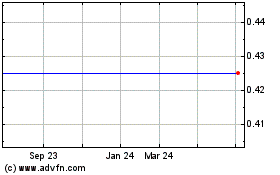Re Joint Venture
April 03 2006 - 3:08AM
UK Regulatory
RNS Number:8323A
Uranium Resources PLC
03 April 2006
Uranium Resources plc
Farm in Agreement
Uranium Resources plc ("URA" or the "Company"), the AIM listed uranium
exploration and development company, has offered a farm in agreement to Western
Metals Limited ("WMT"), a company listed on the Australian Stock Exchange.
The directors consider this transaction to be an excellent opportunity for the
Company because it funds the exploration programme, reduces URA's exposure and
importantly will allow the Company to focus on additional opportunities that it
is actively pursuing to create increased shareholder value.
1 Farm in Agreement
Under the agreement WMT may earn a 40% interest in the Company's Tanzanian
prospecting licences by spending AU$2 million on the licences on or before the
second anniversary of the agreement becoming unconditional. WMT may increase
its interest to 60% by spending a further AU$2 million within a further 2 years.
WMT must spend AU$500,000 within 12 months of the completion of the agreement.
The agreement is conditional on:
1. WMT obtaining all necessary shareholder approvals including approval to
enter into the agreement and all other agreements to be entered into under the
farm in agreement;
2. URA obtaining all necessary shareholder approvals; and
3. Deep Yellow (Tanzania) Limited (a wholly owned subsidiary of the
Company) obtaining all relevant consents under the laws of the Republic of
Tanzanian that are required in order for it to enter into the agreement.
The directors of WMT have advised URA that they are prohibited by law from
considering the offer. Accordingly, they intend to seek a dispensation from the
Australian Securities and Investments Commission and the offer will be put to
the shareholders of WMT in general meeting. This is more fully described in
paragraph 5 of this announcement.
2 Work Programme
Drake-Brockman Geoinfo Pty Ltd, the Company's consultants, has delineated 5
areas in the licences worthy of immediate follow-up. A preliminary
reconnaissance field trip will commence this week. Following this, it is planned
to carry-out detailed mapping, sampling, grid work and trenching to investigate
the anomalies during the 2006 field season. Depending upon these results drill
testing of the most promising targets will be initiated.
3 WMT
WMT is a mineral explorer listed on the Australian Stock Exchange. On
completion of its fundraising (referred to in paragraph 4 below) it will have
approximately 373 million ordinary shares in issue and a cash position of
approximately AU$3.3 million.
4 WMT Fundraising
WMT has announced that it has appointed Dalgety Capital, a licensed dealer in
securities, to manage the placement of 100,000,000 ordinary shares in WMT at an
issue price of 2.5 cents each to raise approximately AU$2,500,000.
The placement will be undertaken in two tranches:
* 40,000,000 shares immediately; and
* 60,000,000 shares, subject to shareholder approval.
Funds raised will be utilised for working capital and, on completion of the
transaction, to finance the initial exploration programme.
WMT has announced that it intends to complete the initial placement within 2-3
weeks, following the lodgement of a Prospectus, and that it proposed to hold the
shareholder meeting in May 2006.
5 WMT Shareholder and Other Approvals
WMT has announced that its directors, having a relevant interest in the
securities of URA, may have a "material personal interest" in the proposal, and
accordingly, pursuant to section 195 of the Corporations Act 2001 of Australia,
are unable to form a quorum to consider whether WMT should enter into the
agreement. Therefore, WMT must obtain the approval of its shareholders prior to
signing the farm in agreement.
WMT also announced that it intends to ask the Australian Securities and
Investment Commission to modify the application of section 195 to enable it to
sign the farm in agreement subject to the approval of WMT's shareholders.
6 WMT's Announcement
WMT announced the transaction to the Australian Stock Exchange this morning.
URA intends to post the full text of WMT's announcement on its website at
www.uraniumresources.co.uk. The directors urge you to read it because it
includes diagrams of the geology and location of the tenements.
7 Change of Directors
David Steinepreis has resigned as a director of URA with immediate effect.
Similarly, Hugh Warner has resigned as a director of WMT.
8 Technical Overview
The information in this section of the announcement that relates to Exploration
Results, Mineral Resources or Ore Reserves is based on information compiled by
Dr Joseph Drake-Brockman who is a Member of The Australasian Institute of Mining
and Metallurgy. Dr Drake-Brockman is employed by Drake-Brockman Geoinfo Pty Ltd.
Dr Drake-Brockman has sufficient experience which is relevant to the style of
mineralisation and type of deposit under consideration and to the activity which
he is undertaking to qualify as a Competent Person as defined in the 2004
Edition of the 'Australasian Code for Reporting of Exploration Results, Mineral
Resources and Ore Reserves'. Dr Drake-Brockman consents to the inclusion in the
report of the matters based on his information in the form and context in which
it appears.
8.1 Mtonya Licences and Geology
The Mtonya area is located in the southern part of Tanzania between Songea and
Tunduru. The village of Mtonya is within the main tenement block. The Mtonya
leases cover the contact between the Usagaren basement to the west and the
Karroo Luwegu Basin to the east. Uranium deposits of the sandstone-type targeted
in the Luwegu Basin comprise more than 30% of currently known uranium deposits
in Africa, including Paladin's Kayelekera deposit in Malawi 200km to the west.
Uranium mineralization occurs at the Mkuju Prospect (owned by OmegaCorp Limited)
to the east and north of the tenement block. The contact zone between outcrops
of Usagaran granites and gneiss and the Karroo sediments is covered by thin
Tertiary to Quaternary deposits.
8.2 Makutapora Licences and Geology
The Makutapora lease lies just north of the town of Dodoma. At Makutapora the
lease covers a portion of an infilled rift (half graben) in Precambrian
basement. The infill sediments are of post Tertiary age and are capped by recent
black Mbuga muds. Uranium has been reported from both the Mbugas as well as from
the deeper sedimentary infill sediments.
8.3 Uranium Targets
Mtonya Area Targets
Within the Mtonya leases the prime target is the uranium in sandstone model.
Simplified this model requires:
* a uranium source area (usually granite-gneiss terrain or acid
volcanics),
* a weathering and erosional event to release the uranium under oxidizing
conditions,
* accumulation of porous sediments in an adjacent basin (usually
fluviatile sandstones),
* sufficiently rapid sedimentation to preserve reduced facies
characterized by pyrite, carbonaceous material and montmorillonite clays,
* precipitation of uranium along the interface between oxidized and
reduced facies (so called redox front).
The nearby Mkuju Prospect is the targeted model of mineralization for the area
and provides the main evidence for the viability of this model. The results at
Mkuju show that significant amounts of uranium were mobilized from basement
rocks and were precipitated within reduced fluviatile sandstones
The Mkuju Prospect was discovered by Uranerzbergbau Gmbh (UEB) in 1978. Due to
the surface oxidation only secondary uranium was located. The best
mineralization was located within 1-5 m thick sandstone beds as disseminated mm
flecks of carnotite. These bodies can be 0.5-2.5 m thick, 3-15 m wide and 5-25 m
long. Channel samples from trenches range up to 2.18 % U3O8. Mineralization was
also noted on re-worked mudstone clasts, pyrite concretions and plant fossils.
The uranium extends over an area of 5x3 km that indicates that the "uranium
front" is large enough to generate ore bodies.
It is postulated that the uranium at Mkuju was derived from the Usagaren
basement that formed the western boundary of the sedimentation. Airborne
radiometric data shows that the granites and gneisses of the Usagaren are
fertile for uranium. That implies that the whole of the western margins of the
Karroo sediments including any palaeo-channels cut into the basement are
prospective for uranium. If at any stage reducing conditions have prevailed,
then extensions or repetitions of the known uranium mineralization are possible.
URA controls a substantial part of this target zone.
A secondary, speculative target is hydrothermal vein and/or metasomatic type
uranium mineralization in the Usagaren basement. Such mineralization has not
been reported from the area but there are reports of radioactive minerals being
found in artesian gemstone operations within Tanzania which supports the
possibility of hydrothermal uranium mineralization.
Makutapora Targets
The Makutapora Prospect falls within the central internal Bahi drainage system
on the Tanganyika Plateau. North-south striking faults of the Tertiary East
African rift system occur throughout the area. The faults exercise a strong
control over both the present day topography and the paleo topography. The
fault controlled channels are filled by fluviatile and lacustrine sediments
informally classified as the "Kilimantindie Cement". The surface expression is
frequently expressed by black, carbonate and gypsum rich clays that form in
shallow local depressions (Mbuga swamps). These frequently fill with water
during the wet season. Surface uranium anomalies are known from several of the
Mbugas (including Makutapora). In 1953 the Geological Survey of Tanzania (GST)
drilled a diamond hole within the Bahi Depression to research the Kilimatinde
Cement. Subsequent radiometric measurements on the core located a 15 cm sample
of strontianite with a radiometric U3O8 value of 0.24%. This result has
recently been followed up by Uranex. They have intersected promising results in
trenches and RAB drilling.
At Makutapora the licence was selected to cover a palaeo-channel that contains
black mbuga muds, quartz sands and calcrete. The main target is defined by a
uranium in groundwater anomaly with an associated 500 ppm U308 assay in calcrete
from archived water bore cuttings that was identified by UEB during previous
exploration in the area. In addition assays up to 285 ppm U308 have been
reported from shallow trenches within calcretes layers in the Mbuga muds at
Makutapora and in adjacent areas. None of these anomalies were followed-up by
drilling.
Exploration by UEB in 1979 identified the following positive factors for further
exploration:
- uranium rich granites (10-80 ppm U3O8) as source rocks
- known occurrences of uranium in drilling (Bahi & Makutapora)
indicating mobilization and precipitation of uranium in the sedimentary
environment,
- known re-mobilization of uranium in the superficial environment,
- abundant channel development.
Targets are calcrete-like deposits in the near surface sediments and sandstone
type deposits deeper within the infill sediments. The term calcrete-like is used
because a direct correlation with the calcrete model is not given.
The calcrete model generally requires:
* high rates of evaporation, internal drainage and very slow rates of
groundwater flow giving rise to saline groundwater and to the development of
porous channel calcretes,
* at certain points along the channel, within but also adjacent to the
calcretes, U-K-V concentrations reach saturation points resulting in the
precipitation of carnotite.
The main questions are whether the drainages are sufficiently stable (given the
Tertiary rifting) to allow the development of substantial deposits and whether
they are sufficiently saline to consistently precipitate uranium.
**ENDS**
Contacts:
Ross Warner Uranium Resources plc Tel: 07760 487 769
Hugo de Salis St Brides Media & Finance Ltd Tel: 020 7242 4477
This information is provided by RNS
The company news service from the London Stock Exchange
END
JVESSUEFESMSEEL
Uranium (LSE:URA)
Historical Stock Chart
From Oct 2024 to Nov 2024

Uranium (LSE:URA)
Historical Stock Chart
From Nov 2023 to Nov 2024
